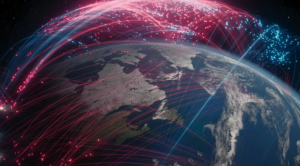
We know that an all-out U.S.-Russia nuclear war would be bad. But how bad, exactly? How do your chances of surviving the explosions, radiation, and nuclear winter depend on where you live? The past year’s unprecedented nuclear saber-rattling and last weekend’s chaos in Russia has made this question timely. To help answer it, I’ve worked with an amazing interdisciplinary group of scientists (see end credits) to produce the most scientifically realistic simulation of a nuclear war using only unclassified data, and visualize it as a video. It combines detailed modeling of nuclear targeting, missile trajectories, blasts and the electromagnetic pulse, and of how black carbon smoke is produced, lofted and spread across the globe, altering the climate and causing mass starvation.
It doesn’t matter much who starts the war: when one side launches nuclear missiles, the other side detects them and fires back before impact. Ballistic missiles from U.S. submarines west of Norway start striking Russia after about 10 minutes, and Russian ones from north of Canada start hitting the U.S. a few minutes later. The very first strikes fry electronics and power grids by creating an electro-magnetic pulse of tens of thousands of volts per meter. The next strikes target command-and-control centers and nuclear launch facilities. Land-based intercontinental ballistic missiles take about half an hour to fly from launch to target.
Major cities are targeted both because they contain military facilities and to stymie the enemy’s post-war recovery. Each impact creates a fireball about as hot as the core of the sun, followed by a radioactive mushroom cloud. These intense explosions vaporize people nearby and cause fires and blindness further away. The fireball expansion then causes a blast wave that damages buildings, crushing nearby ones. The U.K. and France have nuclear capabilities and are obliged by NATO’s Article 5 to defend the U.S. so, Russia hits them too. Firestorms engulf many cities, where storm-level winds fan the flames, igniting anything that can burn, melting glass and some metals and turning asphalt into flammable hot liquid.
Unfortunately, peer-reviewed research suggests that explosions, the electromagnetic pulse, and the radioactivity aren’t the worst part: a nuclear winter is caused by the black carbon smoke from the nuclear firestorms. The Hiroshima atomic bomb caused such a firestorm, but today’s hydrogen bombs are much more powerful. A large city like Moscow, with almost 50 times more people than Hiroshima, can create much more smoke, and a firestorm that sends plumes of black smoke up into the stratosphere, far above any rain clouds that would otherwise wash out the smoke. This black smoke gets heated by sunlight, lofting it like a hot air balloon for up to a decade. High-altitude jet streams are so fast that it takes only a few days for the smoke to spread across much of the northern hemisphere.
This makes Earth freezing cold even during the summer, with farmland in Kansas cooling by about 20 degrees centigrade (about 40 degrees Fahrenheit), and other regions cooling almost twice as much. A recent scientific paper estimates that over 5 billion people could starve to death, including around 99% of those in the US, Europe, Russia, and China – because most black carbon smoke stays in the Northern hemisphere where it’s produced, and because temperature drops harm agriculture more at high latitudes.
It’s important to note that huge uncertainties remain, so the actual humanitarian impact could be either better or worse – a reason to proceed with caution. A recently launched $4M open research program will hopefully help clarify public understanding and inform the global policy conversation, but much more work is needed, since most of the research on this topic is classified and focused on military rather than humanitarian impacts.
We obviously don’t know how many people will survive a nuclear war. But if it’s even remotely as bad as this study predicts, it has no winners, merely losers. It’s easy to feel powerless, but the good news is that there is something you can do to help: please help share this video! The fact that nuclear war is likely to start via gradual escalation, perhaps combined by accident or miscalculation, means that the more people know about nuclear war, the more likely we are to avoid having one.
